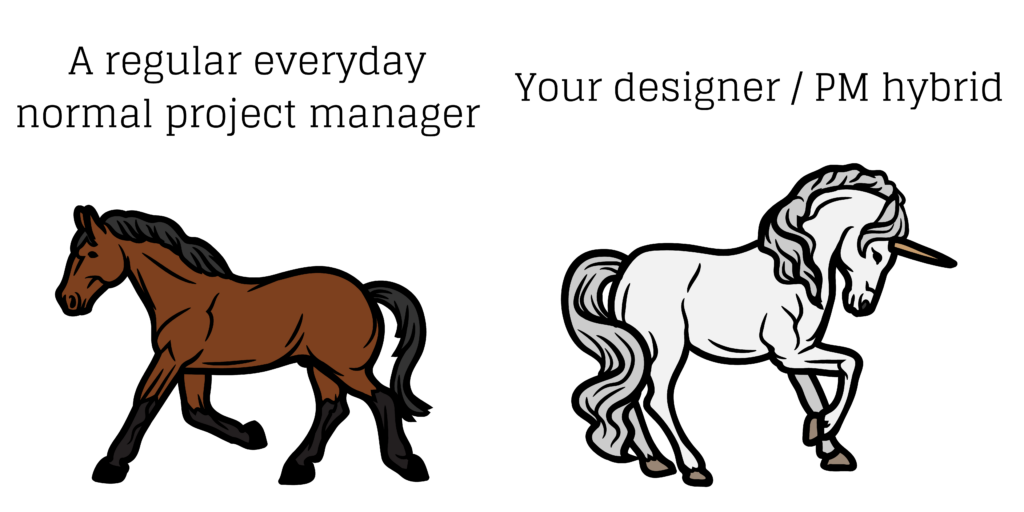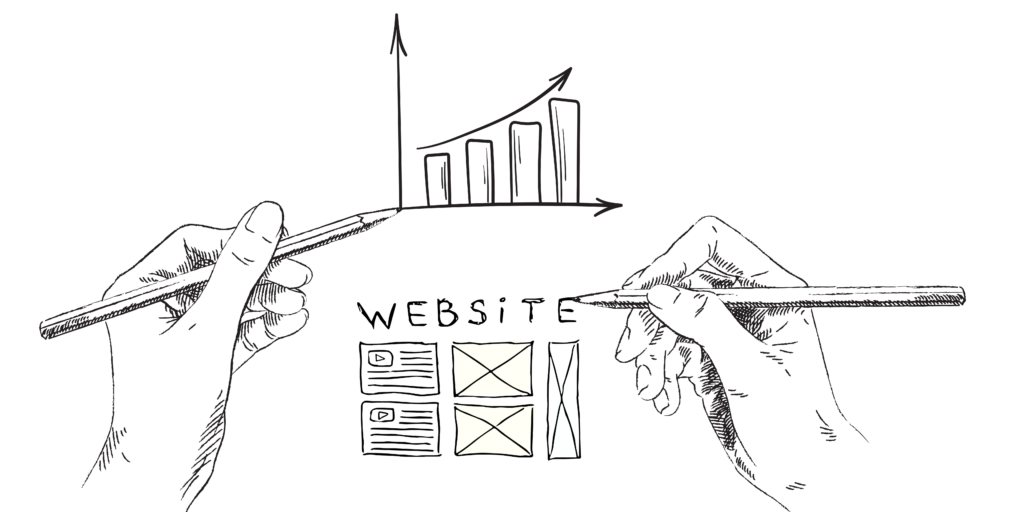
The Cheeky Monkey Media Blog
A few words from the apes, monkeys, and various primates that make up the Cheeky Monkey Super Squad.

5 Advantages of a UX Designer/Project Manager Hybrid
 December 20, 2021 / Treena Bjarnason
December 20, 2021 / Treena Bjarnason
So here’s the thing, I love my job. (I promise my boss isn’t holding a gun to my head as I write this.) I do, genuinely, love my job. The reason? Because I get to be both a UX Designer and Project Manager for clients. And there are a ton of advantages of working with a UX Designer/Project Manager hybrid.
Why Do I Love My Job?
Here at Cheeky Monkey Media, we believe in the right person for the right job, and I’ve always been a little hard to fit.
If you went around and asked my closest friends for descriptive words you would probably get answers like “blunt”, “pragmatic”, and maybe even “bossy” (or a less politically correct synonym). My earlier background was in office management and finance – pretty ironic for someone who hated math in high school, but money and statistics always made more sense to me than abstract math. I sound fun at parties, yes?
Analytical Thinker, Meet Creative Mind
I’m also a designer. An artistic type, is synonymous with being unstructured, sensitive, and innovative in a way that “numbers people” are not. If my photoshop experience was a person, it could legally vote and drink – I have my designs printed in magazines, on websites, and even a full vehicle wrap – ok, maybe some of the ego stereotypes are true. The point is, I love art and being creative.
When working with numbers I was often bored and unfulfilled. I was skilled in my position, but certainly wasn’t passionate about finance the way my coworkers were. So I decided to go back to school in order to get into the tech industry.
A Unicorn Role
When I accepted a Project Management (PM) role at Cheeky Monkey, I emphasized that I also wanted to grow my skills and portfolio for web design. The leadership team agreed, and my journey in web development officially began.
From where I sit today, I can’t imagine any other way of operating in this industry, both from an agency and client perspective. To me, it’s the most natural thing in the world for your PM to also be adept at design. Who wouldn’t want the advantages of a UX Designer/Project Manager hybrid? Who better to guide the development of your project than the person you spent hours with to suss out the details and purpose of your unique project? The person who, with love and care, designed the flow, look, feel, and function of your website. At this point, I am as invested in your project as you are because I want to see it come to life – THAT gives me the deep satisfaction I have lacked in other positions.
Advantages of a UX Designer/PM Hybrid
1. Design thinking is critical thinking
One of the primary skills you want in a PM is someone with strong critical thinking skills. The flow for critical thinking usually goes something like:
-
-
- Identification of a problem (foreseeing potential issues before they occur)
- Analysis (knowing what you know, what you do not, and asking better questions)
- Conclusions (the ability to make sense of an information hodgepodge)
- Problem Solving (planning the best way to solve a problem)
- Verify (did the solution work as intended and what can we do differently next time)

-
And the most important skill for critical thinking: Curiosity. Without a natural curiosity, your PM wouldn’t be able to identify potential problems, analyze the situation fully, see conclusions that others may miss, or problem-solve in the most effective way.
What about design thinking? The design thinking flow can be summarized like this:
-
-
- Empathize (with the end user, whether it is a customer or other stakeholder)
- Define (identifying potential issues before they occur)
- Ideate (the ability to make sense of an information hodgepodge)
- Prototype (planning and visualizing the best way to solve a problem)
- Test (did the solution work as intended and what can we do differently next time)
-
And the most important skill for design thinking: Creativity. Without creativity, your designer wouldn’t be able to empathize deeply to discover the needs of your users, or develop the wealth of knowledge required to come up with innovative solutions.
Sounds pretty similar, don’t you think?
2. Agile Stakeholder Interviews
Stakeholder interviews are one-on-one conversations with people who have a monetary or emotional investment in the project you’re working on. Sometimes this is the owner, employees, or even your users. When your PM is also a UX designer, they’re adept at this type of interview process and can quickly get to the heart of the project, such as understanding business goals, technical constraints, usability problems, and more.
Often, designers are only part of a project’s planning phase, and maybe post-launch follow-ups. But when your designer is your project manager, they are constantly working with you to problem solve, consult, and update the project in an agile manner.
3. Being Realistic of Scope
It’s a natural inclination of designers to dream big. We always want to be on the cutting edge of design and technology, and we can’t help but to want everything to be beautiful. Unfortunately, not many projects have the unlimited budget required to utilize state-of-the-art technologies or develop all of the slick tricks of complex designs.
As a Project Manager, it’s my job to keep your project on task and on budget. Knowing your requirements and restrictions, I will always design in a practical way. Your wireframes won’t include features and flair that your budget cannot handle, so there won’t be disappointment halfway through when that cool feature you loved is out of scope.
4. Connecting Business Goals and User Goals
If you’ve ever worked with a UX Designer or spent much time in the space, there is a chronic complaint that UX is forced to satisfy the company, rather than the end user. While I feel this can be true, I think these “letter to the editor” type rants ignore the reality that any project is still a business venture, and a holistic strategy will always find the balance of business goals and user goals.
With my background in finance and management, I understand business operations and the (sometimes gritty) reality behind choices companies are forced to make.
5. Attention to Detail
Another thing PMs and designers have in common? A sharp eye for detail. Fine details can make or break a design. Most users will decide to stay on your site or bounce after a matter of seconds. If the details don’t line up, the unconscious first impression will be a negative one, and then you’ve lost that visitor before they even get started. We are not only analytical about data and processes, but we are brand aware and know the importance of staying on brand. Even without the marketing team reminding us regularly!
From a PM’s perspective, projects often involve a lot of moving pieces, and we need to be able to ingest those details and organize them in a way that makes sense for both the client and my development team. Every job starts with breaking down overarching goals into manageable, detailed pieces.
Making Sense and Cents
Some have called us unicorns, but certainly, our value as Project Manager / UX Designer hybrids is on the rise. From a client’s perspective, it’s the best bang for your budget and an advantage that takes “collaborative” to a whole different level. Your projects will thank you for it.
Reach out if you’d like to work with this unicorn and our monkeys.

